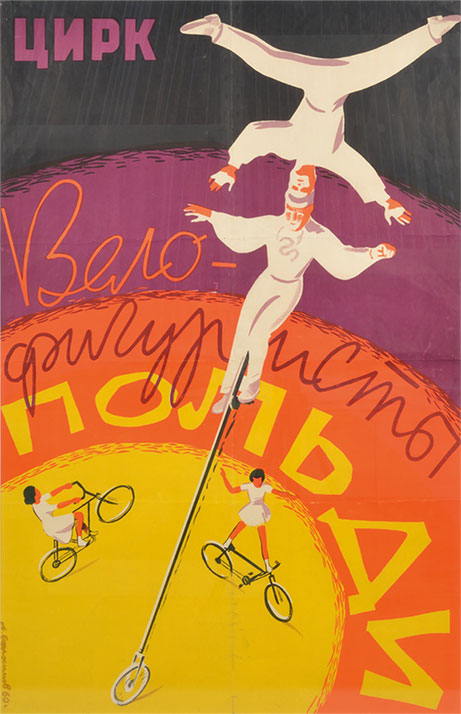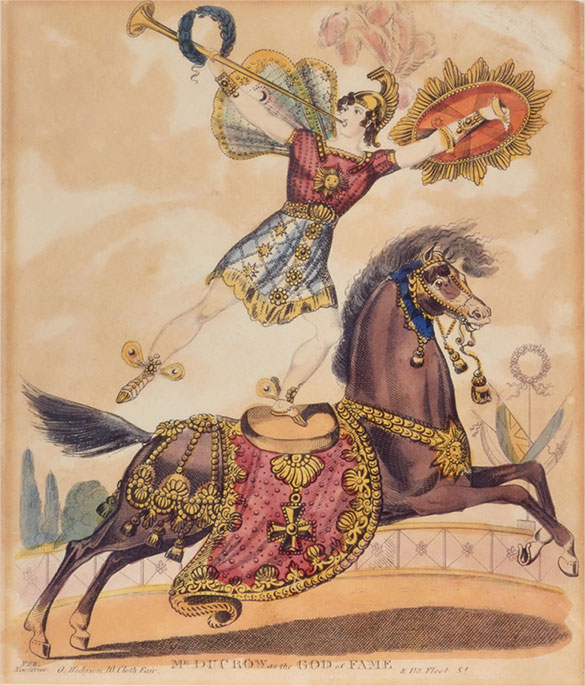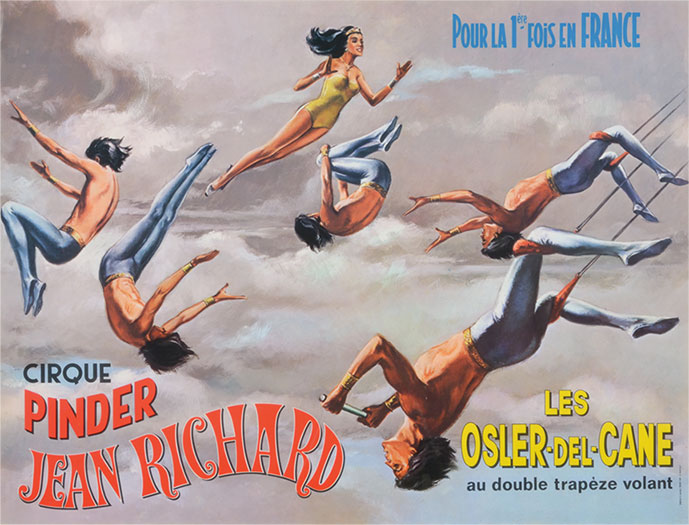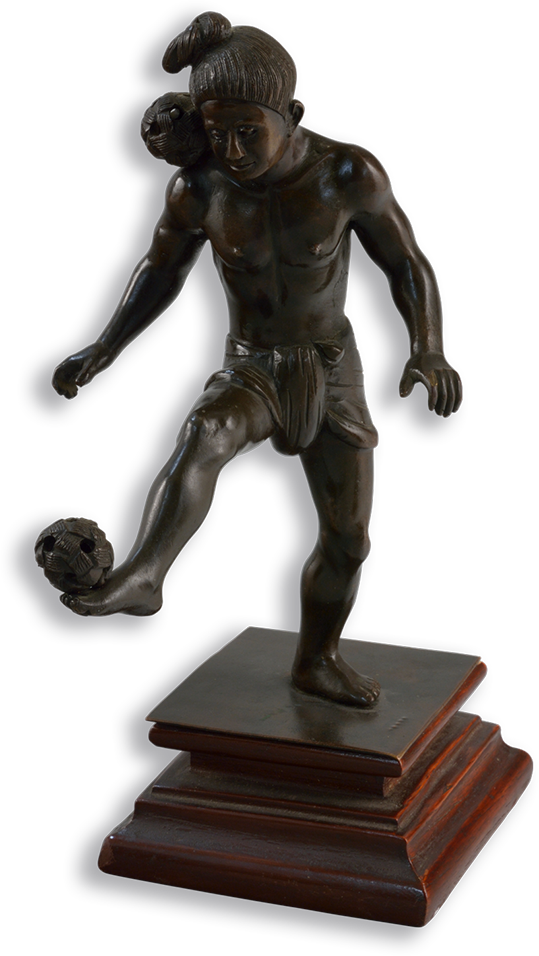CIRCUS DISCIPLINES
(On the TOHU stage, Luza holds a red ball in front of her head. To the right, a woman is performing aerial acrobatics. Behind, two men are performing floor acrobatics. Energetic instrumental music is playing.)
Narrator: You look like a clown with your red nose! That’s funny. But you know, Luza, there’s more than just clowns in a circus. Look around!
(Luza hands the ball to one of the floor acrobats. He performs a front Salto on the hands and feet of the other artist, who is lying on the floor.)
Narrator: There are acrobats on the floor and in the air. You’ll find them later in the next photo, and you can watch them to earn stars. And don’t forget the hand balancers, and the jugglers.
(Luza walks to the artist twirling in the air, gives her the ball and sits under her. The artist drops the ball to the floor and Luza collects it. She then moves toward an artist doing a handstand on canes. The artist touches one foot to Luza’s head. Luza moves away and gives the ball to a juggler, who is already juggling. She chases after him, but he disappears behind a curtain. Then she sees a clown nose as red as her ball. She takes the nose and puts it on her face.)
Narrator: Hey! Where’d the clown go? Oh! It’s you! Hahaha you’re so funny! But aren’t we missing one type of circus performer?
(Luza finds a hobby horse. She mounts it and pretends to be an equestrienne.)
Narrator: That’s right, the one who performs with horses! Very funny, Luza. You can’t just grab a horse and become an equestrian acrobat.
Hoop Acrobats
Credits: Jacob-William Collection, TOHU
Pencil drawing of five men facing five other men. They are holding ten hoops in a row. A man is shown jumping on a springboard, through the hoops and landing at the other end.
How on earth did that man jump that far through ten hoops? Look carefully. There’s a small springboard on the floor.
This picture is very old. It was drawn by an Italian artist in Paris in 1599. That means that acrobats have been using things to help them jump higher for a long time.
Today, you can see circus artists in trampoline acts jumping really high to perform impressive acrobatic moves.
These techniques belong to the discipline of acrobatics.
Musical Clowns
Credits: Jacob-William Collection, TOHU
Yellow, red and blue painted poster with several clowns and the title “Les Pinder et les clowns musicaux” [“the Pinders and the musical clowns”].
Clowns add a touch of humour, fun and sentimentality to a circus.
The white clown wears white face makeup, a white hat and a sequined costume. White clowns are usually in charge. Do you see one on the poster?
The Auguste clown has a red nose and wears oversized shoes. He is often mistreated by the white clown, as you can see at the top left. Often, clowns are true acrobats who know how to play music and juggle.
Soviet Balancing Artists
Credits: Jacob-William Collection, TOHU
Russian poster showing a top view of two men balancing on a unicycle with a very high saddle. Two women are standing on their bicycles below. They appear to all be in a circus ring.
Cycling in a circus is quite an experience! The bicycles can have one wheel – those are called unicycles. Or they can have two or three wheels... or more!
The saddle might be normal or very high, like the one in this Soviet-era poster from 1963. That’s a giraffe unicycle.
No matter the bike, these performers ride them in their balancing acts. They’re called balancing artists for a reason. They stand, perform jumps and do much more, all on their bikes.
Equestrian
Credits: Jacob-William Collection, TOHU
Drawing of a man in an ornate costume who is playing the trumpet. He is balancing on one foot on the saddle of his horse, which is also in costume.
No, this man and horse are not gods! But they are able to perform amazing tricks, because they are circus artists.
The man is Andrew Ducrow. He was an English equestrian born in 1793. He did acrobatics while standing on his horse, as seen here. He even performed numbers with several horses and jumped between them.
This is part of the discipline of the equestrian arts – arts with horses.
Flying Trapeze Artists
Credits: Jacob-William Collection, TOHU
Poster showing six trapeze artists, including five fair-skinned bare-chested men in tights and a woman in yellow leotards with the text “Jean Richard Pinder’s Circus. For the first time in France: the Osler Del Canes on the Double Trapeze”.
Can people fly? Not exactly, but that’s what these South African trapeze artists might be feeling, as they launch into the air high above the circus ring.
Trapeze is an important kind of aerial acrobatics.Here, the acrobat hangs from a bar which is connected to the ceiling by two ropes. There are different types of trapeze. This one is called the flying trapeze.
The three men and one woman on the left are called flyers. That’s because they release their hold on the trapeze while in mid-air, and perform tricks while ‘flying’, on their way towards the catchers, on the right.
If you’re a flyer, it’s best not to be afraid of heights!!
Juggler from Myanmar
Credits: Jacob-William Collection, TOHU
Bronze statue of a man wearing only a loincloth who is balancing a ball on his right foot and another on his right shoulder.
Shhh! Don’t make too much noise. Look how focused this man is.
All his muscles are tense, his arms are held wide, and his knee is bent for balance. The last thing he wants to do is drop the woven bamboo balls on his foot and shoulder.
He is a juggler. In his act, he does things like tossing and catching different objects and keeping them balanced.
Many different objects, like balls and bowling pins, can be juggled. You can even try it at home with some oranges.
Floor acrobatics
Artists: Téo LeBault and Victor Crépin
(Two young fair-skinned artists of different heights perform acrobatics on a stage. They get up and approach the camera. Joyous instrumental music is playing.)
Narrator: Hi Téo and Victor! It’s really impressive what you guys do together! You really have to trust your partner to do that! How long have you known each other?
(Téo is standing on Victor’s shoulders. He puts his hands in Victor’s, then swings himself to balance upside down. Victor raises him by fully extending his arms. Téo slowly lowers his legs and drops to the floor.)
Téo: We’ve known each other for exactly two years. We met at the Montréal National Circus School. We became friends and after a few months we thought, “Why not try some hand to hand?” And we’ve been a duo for eight months since then.
Narrator: Do you each have a set role?
(Téo faces the camera.)
Téo: So I’m the flyer and Victor is the carrier, simply because there’s a weight difference and we each have our strengths and weaknesses. So we balance each other out.
(Téo is standing on Victor’s shoulders. He puts his hands in Victor’s, then swings up to balance upside down. Victor raises him by fully extending his arms.)
Narrator: Besides trust, what else does it take?
(Victor is lying on his back, facing the camera. Téo is sitting on Victor’s feet and hands. With Victor’s help, Téo performs a front Salto and lands back in the sitting position on his partner. Close-up on Téo’s feet supported in Victor’s hands. Téo jumps backwards and Victor catches him with his feet. Close-up showing that Victor’s feet are bigger than Téo’s. The two artists are standing. Victor helps Téo perform forward and back Saltos by holding him by one arm.)
Victor: So it takes a lot of trust, but there are other things too, trust is more like the end goal, it doesn’t come naturally, it’s something you have to work to build. You need to put in a lot of work, and since it takes so much work you need to be passionate. A lot of work also means a lot of time spent together, so it’s really important to listen to each other. You always have to ask how he feels, how it’s going for him, so we can work together optimally.
Narrator: And what’s your favourite part?
(Téo faces the camera, followed by a close-up on the two artists. Téo is balanced on Victor’s hands with his head upside down. Their two heads are very close. Their expressions reveal a very close bond. We can also see their muscles trembling.)
Téo: The teamwork, the connection you create with your partner, being on stage together instead of all alone, it creates a different dynamic and I think that’s beautiful.
(Joyous instrumental music is playing. The camera is mounted on Victor’s head so we see what he sees. His feet are in the air and Téo is balanced on him. He jumps and ends up sitting on Victor’s feet. Téo and Victor are standing one in front of the other. Téo performs a back Salto and lands standing on Victor’s shoulders, who gives him a little help. Téo balances upside down on Victor’s hands, then drops down in front of him.
The two artists are facing the camera.)
Narrator: I knew circus takes good teamwork but you two really prove it.
Victor and Téo: Thank you!
Aerial Acrobatics
Artist : Tuedon Ariri
(A young woman with dark skin and dressed all in black performs aerial acrobatics with straps on a stage. She is then seen in close-up.)
Narrator : Hey Tuedon, here you are!
Tuedon : Hi, I was just rehearsing
(Tuedon is wearing a white costume and is performing acrobatics with the aerial straps.)
Narrator : Oh yes, you spent a lot of time in the air, don’t you ever get dizzy?
(The camera is mounted on Tuedon’s forehead, and we see that when she twirls on the straps, everything turns around her. Then we see a long shot of Tuedon spinning around, attached to the straps by one hand, then by the neck.)
Tuedon : Well, sometimes I do. I used to get really dizzy when I first started training and actually vomited one time in the middle of the performance area or the training area but now I’m okay ‘cause I do it everyday so I don’t get dizzy anymore.
Narrator : Can you talk about your training before a performance?
(Close-up on Tuedon, who appears very focused. Then she faces us and speaks.)
Tuedon : Yes, so before a performance I always start by stretching out all my muscles and my splits and my back’s flexibility for about 15-20 minutes. Then I go on to the straps and do physical conditioning, shoulder exercises, leg lifts, chin ups to keep my muscles strong and then I take a moment for myself to breath and reflect on the performance to come. And then, I go on stage focused and ready for the show. (laughs)
(Tuedon is again spinning on the straps. We see what she sees – her legs, arms and the set spinning around her.)
Narrator : You seem really passionate, how did this all start?
(Tuedon is in the air. Her upper body is held by a strap and her legs by another. She is spinning. Then she is attached to the straps by a single hand and is spinning. All of her muscles are taut. Then she is supported only by her back and performs aerial acrobatics.)
Tuedon : I came to Montreal and I had a gymnastics competition and saw students from the National Circus School and they performed and I just thought that their performances were so amazing and so powerful and not competitive and so that really inspired me, the idea to work together with the people who are around me rather than competing against them. And I went to the summer camp at the school and did that for 3 years before auditioning for the school and doing 6 years there. (laughs)
Narrator : And why the straps?
(Tuedon, on aerial straps, rocks back and forth then goes up and down in the air. )
Tuedon : Straps I decided to do because I arrived at the school and I didn’t know what discipline I wanted to do. You know, there are so many to choose from and there was a girl there who did already contortion straps and I thought her number was just so powerful and the way she used her body, I thought it was amazing and that’s when I decided that’s kind of the direction I want to go in.
(Tuedon is standing on the stage, back to the camera with her straps in her hand)
Balancing
Artist: Aude Lavergne
(Close-up on the head of an upside down young woman. The camera pulls out and we see a woman with fair skin in a red costume doing a handstand on canes. She gets down and faces the camera.)
Narrator: What’s happening? Is there a problem with the camera? Ah no, I get it, you’re the one that’s upside down, Aude. It can’t be easy to balance upside down like that. What does it take?
(Aude is balancing upside down on the canes. She brings her legs together. Close-up on her trembling hands that are supporting her entire weight as Aude moves from one cane to the other.)
Aude: No, it’s not easy, it takes a lot of body awareness. For example, when you’re standing you raise your leg, but upside down you’re actually lowering it. It also takes a lot of patience because you need to be consistent in your training before being able to perform at the professional level, which takes at least five years.
Narrator: What are those things you’re balancing on called?
(Close-up on Aude, then on the canes.)
Aude: They’re called canes. My contemporary canes with “nice” torn up tape. It makes them less slippery.
(Close-up on Aude’s feet, then pedestal down to her head.)
Narrator: What’s your favourite thing about your job?
(Aude faces the camera.)
Aude: I really like analyzing the body and being able to perform certain positions. I love that I get to train pretty much every day. I really like connecting with the audience, they inspire me to inspire them and that means the world to me.
(Aude moves to her canes, puts one foot on them, then balances on her hands. Close-up on her hands, then on her turning on the canes. She dismounts.)
Narrator: Do you adapt your performance based on the audience’s reactions?
Aude: Sometimes the audience likes movements more than I expected so I add them to my performance or I keep them in reserve. My act evolves based on what the audience gives me and their energy.
(Aude faces the camera.)
Narrator: I can see that the audience is important for a lot of artists like you, it’s almost like they’re a part of the performance team. Thank you so much.
Aude: Thank you.
Clowning Art
Artist: Nathalie Claude
A middle-aged woman with fair skin and red hair is sleeping on a lounger. She is suddenly awoken by an alarm.
She is outside, next to some old metal lockers. She fights to fold the chair.
She grabs a boot from the top of a locker and shakes it next to her ear. She smiles and tips up the boot to remove an egg. She tries to break it on her forehead, then swallows it whole.
She gets into one of the lockers with a shower cap on her head and a towel over her shoulder, as if she was going to take a shower. She comes out with a hat, puts something in her pocket, then checks herself and her cart over.
She has a broom, buckets, a shovel and many other items on her cart. She whistles as she pushes it. She walks down the middle of a street. As she stops to tighten a shoelace, the cart rolls away down the slope.
She runs to try to catch it. We hear a big crash offscreen, as if everything is falling off the cart.
The woman is back on the street with her cart, whistling as if nothing happened. She stops suddenly, looking surprised.
Juggling
Artist: Santiago Rivera Laugerud
(A young man is on a stage, juggling some white balls. Hearing the narrator speak to him, he loses concentration and drops the balls. The camera moves closer to him.)
Narrator: Hi Santiago! Wow you juggle a lot of props, do you often drop them during a number?
(Santiago is facing the camera and holding three balls in his left hand.)
Santiago: Yes, all the time, juggling is a discipline with a lot of risks. Well not necessarily physical risks but the problem is that every single throw represents a drop, so you have to catch them all!
(Santiago rolls a ball the length of his arms, then juggles three balls.)
Narrator: And what do you do when it happens?
Santiago: Most of the times, I improvise, trying to do something that work with the show or with the act that I am creating
Narrator: Where does your ability to adapt come from?
(We watch Santiago juggle as though we were sitting in front of him, under the balls flying through the air. Santiago speaks, facing the camera. He then juggles three balls behind his back.)
Santiago: I began doing circus when I was really young. I began dancing when I was 5 then I began juggling when I was 7. I am originally from Guatemala and a lot of travels that I have done and lot of shows and different disciplines that I have tried, have given me the ability to actually explore and do different things on stage.
(Santiago juggles the balls from front to back, then quickly from one hand to the other as he crosses his arms.)
Narrator: Oh yes, that's right, you're from Guatemala! And you came to Canada to study, you travelled a lot!
Santiago: Yes I had to travel a lot to different places in Central America and North America so that I can learn different abilities so that I can be here, in Canada.
Narrator: Why did you choose to come to Montreal?
(Santiago then juggles as he walks in a circle.)
Santiago: The circus in Quebec has a really good reputation and the fact that it is so important around the world, brought me all the way here.
Narrator: What do you like most about it?
(Santiago juggles lying on the floor.)
Santiago: Circus gives you the ability to mix different disciplines such as dance, theatre, acrobatics and different stuff. And it makes you feel free, it gives you the ability to move and to connect with other people.
(Santiago juggles standing, on the floor, lying on his side, and balances a ball on his temple. He returns to juggling standing up, then moves one ball close to the camera.)
Equestrian arts
Artists: Andréanne Dumont and Edgefield
(A young fair-skinned woman in a Cavalia shirt is walking outside next to a big top. She is carrying a horse saddle.)
Narrator:
Hi Andréanne, do you have a few minutes to talk?
(Andréanne stops to face us and places the saddle on a chair.)
Andréanne: I was on my way to brush my horse, Edgefield, but I’d be happy to answer your questions.
Narrator: So your performance partner is a horse! That must be incredible! Isn’t it difficult to perform your acts?
(Andréanne brushes and washes her horse, Edgefield, in a stable. From her look and smile, you can sense the partnership and love that bind them. Andréanne leads Edgefield under a big top. A group of male and female riders in costume mount horses and perform acrobatics on the horses in a variety of sets under a big top.)
Andréanne: It’s not too difficult when you know how to speak horse. But you need to spend a lot of time with horses to learn their language and to understand how they work and how they communicate with us through their bodies, eyes and ear movements. All these little signs are their language and when we learn and understand it, we can develop a relationship and bond of trust with them. And when they trust us, they have a lot of fun on stage with us and they’ll even play tricks on us and ask us to improvise with them every night, at every show.
Narrator: Can you tell us about a time when that happened?
(Andréanne is facing the camera, then we see horses and acrobats in excerpts from Cavalia shows. They perform in a water-covered ring before giving a final bow.)
Andréanne: There were quite a few times on stage when I had to improvise with my horses. Every night my horse would decide to change up the routine we had practised together. Sometimes he’d want to turn right instead of left. Or he’d change the routine and roll around in front of the audience, alone on stage. This meant I had to stay on my toes and be spontaneous so I could play with him.
Narrator: You seem really passionate about your job.
(Andréanne is facing the camera, then we see horses and acrobats in excerpts from Cavalia shows. A group of riderless white horses gallop through water around the ring. Andréanne and Edgefield train outside with other horses and riders.)
Andréanne: Yes, I fell in love with horses when I was very young. It was only after university, many years later, that I decided to go into this career and I joined Cavalia, which is an equestrian art touring company where I met Edgefield. With Edgefield, I learned how to be an equestrian performer.
Narrator: What type of acrobatics do you do with Edgefield?
(Andréanne is facing the camera, then we see her alone with Edgefield in a big top. Then a number of male and female riders jump their horses over obstacles held by artists in fairy tale decor under a big top. In a desert decor, horses without tack are walking and being led by costumed artists running beside them. Then, a woman alone at the centre of the ring directs the horses just by her body movements.)
Andréanne: I specialize in doing acrobatic jumps over obstacles with Edgefield, so we perform a routine that is interspersed with obstacles that change direction and location throughout the act. Edgefield also does bareback. Bareback is a discipline that doesn’t use any equipment, so we use only our bodies and voice to communicate with a horse.
Narrator: That’s fascinating! Thank you so much, and say hi to Edgefield for me!
(Andréanne, facing the camera, answers with a big smile.)
Andréanne: Yes, with pleasure! Thank you so much.


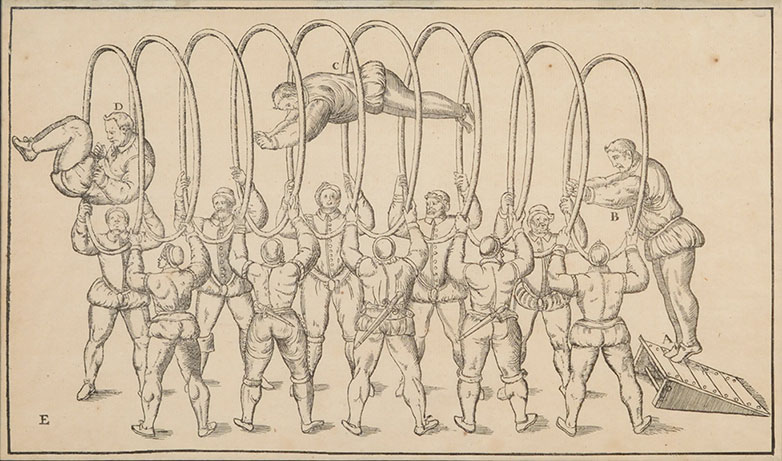
![Yellow, red and blue painted poster with several clowns and the title “Les Pinder et les clowns musicaux” [“the Pinders and the musical clowns”].](/asset/images/myImage360/circusdisciplin/sd/cd_affiche_clowns_img.jpg)
